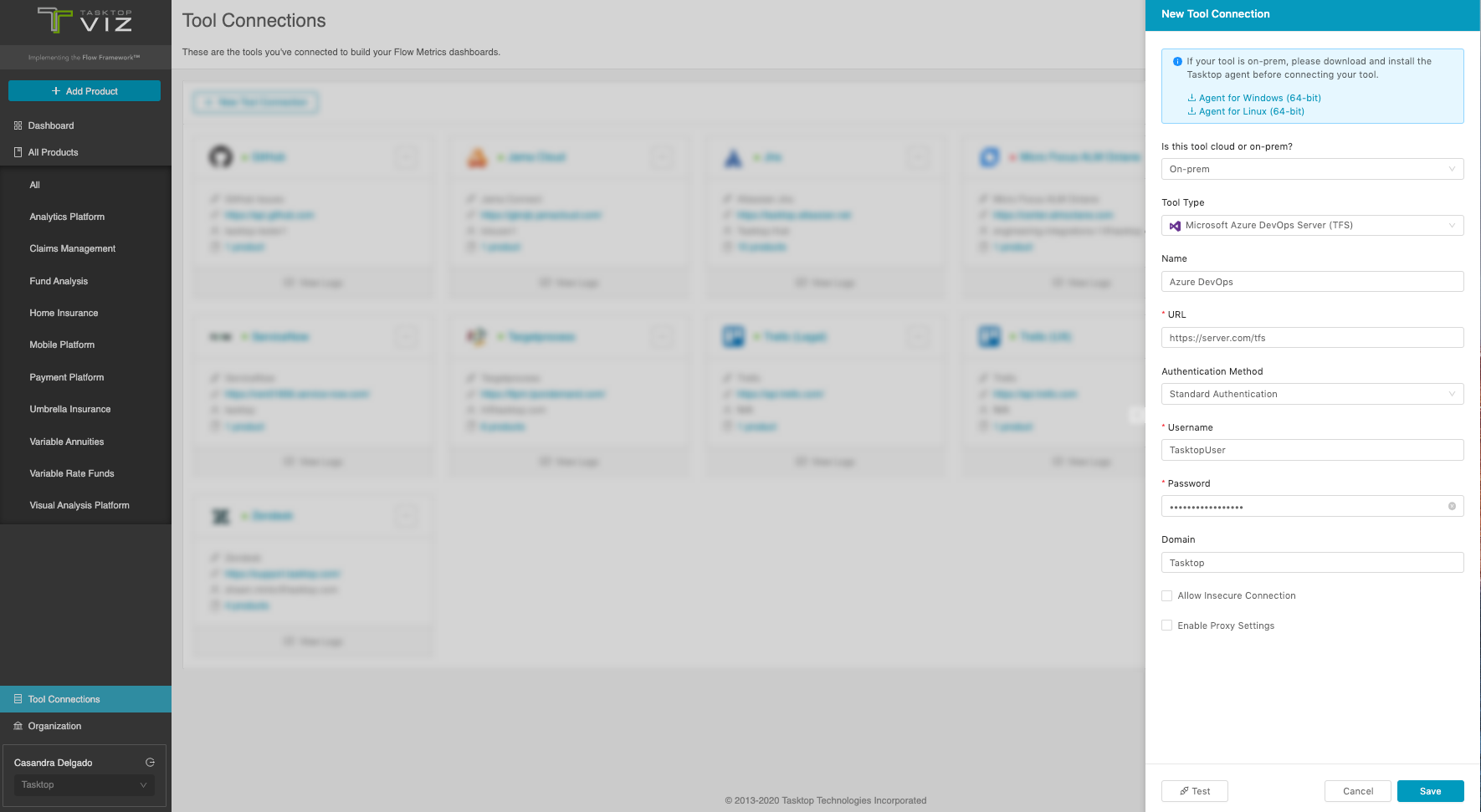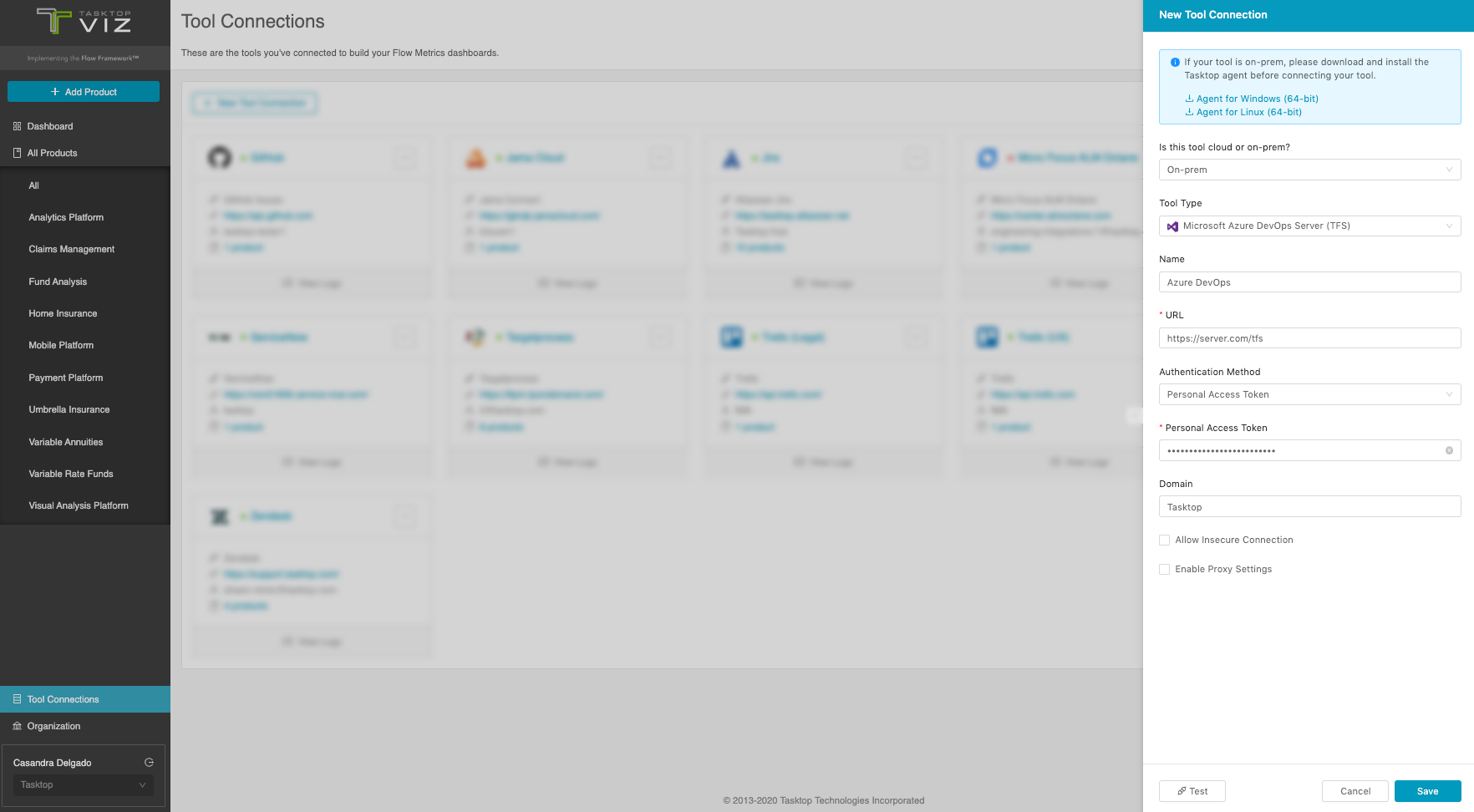Microsoft Azure DevOps Server
- Last updated
- Save as PDF

Overview
Microsoft Azure DevOps Server (formerly TFS) provides work item tracking, source control and Agile project management for the software delivery lifecycle.
Many organizations, particularly those building for Microsoft platforms, use Azure DevOps Server as their planning and reporting center. However, when members of the extended software development and delivery tool adopt specialist tools, the reports from Azure DevOps Server no longer reflect up-to-the-minute data.
Supported Extensions
Microsoft Test Manager
Microsoft Test Manager is a pure client-based application used to access Azure DevOps Server. As such, the Azure DevOps Server connector can be used to access Azure DevOps Server artifacts that were created or updated by Microsoft Test Manager.
Modern Requirements4DevOps
Built into Azure DevOps, Modern Requirements4DevOps (formerly Modern Requirements4TFS) provides requirements management by extending the visualization, reuse, and reporting capabilities of Azure DevOps.
Modern Requirements4DevOps works with supported Azure artifact types. Therefore, once artifacts from Modern Requirements4DevOps are published to Azure, those artifacts will be supported by the Azure DevOps connector within Viz. No additional Azure configuration is needed for Modern Requirements4DevOps, and artifacts created and modified by Modern Requirements4DevOps can be used by Viz as easily as other supported Azure types.
Connector Setup Details
This section describes the basic steps needed to prepare your Azure instance for use with Viz.
Minimal User Permissions & Viz User
We recommend that you create a new user within your external tool, to be used only in Viz. This is the user information you will enter when setting up your tool connection within Planview Viz. By creating a new user, you will ensure that the correct permissions are granted.
In general, your user account should have sufficient permissions to read artifacts in your tool.
Your user should have a secure password or token. Please be aware that Viz will not allow you to save a tool connection utilizing a weak password/token, such as tasktop.
Create an Azure user account to be used by Viz and ensure that it has sufficient permissions to read artifacts in the Azure projects and view project-level information. Making the user account a member of the default Azure Contributor group of all the necessary projects is sufficient in most cases.
Connecting to the Microsoft Azure DevOps Repository
Users can use either an On-prem agent or cloud agent to connect to Azure DevOps Server.
For On-prem agent:
- Agent for Windows (64-bit)
- Agent for Linux (64-bit)
Once the On-prem agent is downloaded, review the README.txt file, which will contain instructions on how to download and store the external files.
For more information on how to download and install On-prem agents, click here.
Standard Authentication
Beginning on March 2, 2020, Azure DevOps Services (formerly VSTS) users must use Personal Access Token authentication, as standard authentication will no longer be supported by Microsoft. Azure DevOps Server (on-prem) users can continue to use standard authentication.
Required Fields:
- URL
- Example Format: https://server.com/ado
- Username
- Note: Do not include the domain in the username (i.e., TASKTOPDEMO/Administrator).
- Password
- Domain
- This is the authentication domain.
- Only required if the Azure DevOps server requires a domain (for example, for Windows Authentication [NTLM or Kerberos]).
- Not required for local accounts that have Basic Authentication enabled on the server.

Personal Access Token
Required Fields
- URL
- Example Format: https://server.com/ado
- Personal Access Token (generated in Azure)
- To find the token, see Microsoft PAT docs
- Azure DevOps Server 2019 and earlier users
- When creating a Personal Access Token to use with Viz, the All Scopes Authorized Scope must be selected for Azure DevOps Server (on-prem) users.
- Azure DevOps Server 2020 and above users
- The following permissions are required for Azure DevOps Server users for “all accessible organizations”:
- READ access for Projects, Teams, and Identity
- READ/WRITE access for Work Items
- READ & MANAGE access for token administration
- For Hub versions 22.1 and earlier, READ access for Graph API is required for person reconciliation
- The following permissions are required for Azure DevOps Server users for “all accessible organizations”:
- Azure DevOps Services (cloud) users
- The following permissions are required for Azure DevOps Services users:
- READ access for Projects, Teams, and Identity
- READ access for Work Items
- For Hub versions 22.1 and earlier, READ access for Graph API is required for person reconciliation.
- The following permissions are required for Azure DevOps Services users:
Optional Fields
- Domain (this field should be ignored for Personal Access Token Authentication)

OAuth 2.0 Client Credentials Proxy Authentication (For Microsoft Azure DevOps Server on-prem only)
Azure DevOps Server 2018 update 2 and later
This authentication method enables secure, token-based access via a proxy, using the client credentials.
Note: Microsoft Azure DevOps Server does not currently support OAuth 2.0 Client Credentials authentication. As a result, the Microsoft Azure DevOps Server connector cannot connect directly with the Microsoft Azure DevOps Server repository using the OAuth 2.0 Client Credentials authentication method.
Prerequisites
-
The authenticated user should have ADO instance-level permissions.
-
Set system property com.tasktop.connector.microsoft.tfs.teeNotRequired=true in VIZ. Please contact customer care to apply this system property.
Other Configuration Settings
Historical Data Ingestion
When you first establish a tool connection with Microsoft Azure DevOps, the system can retrieve historical artifact data through revision records. Historical data ingestion enables Viz to calculate metrics from periods before the tool connection was created.
Supported Field Types
The following field types are supported for historical data ingestion:
- String
- Single-select
- Multi-select
- Boolean
- Person
- Date
- Long
- Double
Unsupported Features and Field Types
Test Management
Test Management Types are not supported for historical data ingestion.
Unsupported Field Types
The following field types are not supported:
- Comments
- Attachments
- Rich Text
- Weblink Fields
- Single and Multi ArtifactLink Fields
- Single and Multi ContainerLink Fields
The following fields are not supported:
- Formatted ID
- Location
- Revision
Supported Artifacts
Supported Work Items
|
Supported Work Item Type |
Applicable Repository Versions |
Unique URL? |
|---|---|---|
|
All out-of-the-box work items (such as Bug, Feature, Issue, Task, User Story, etc.) Note: Changesets, Test Plans, Test Suites, Test Runs, Test Points, and Test Results are not supported |
Any supported repository version: |
Yes |
|
All custom work items Note: Changesets, Test Plans, Test Suites, Test Runs, Test Points, and Test Results are not supported |
Any supported repository version: |
Yes |
Supported Containers
|
Containers that can synchronize between repositories |
Applicable Repository Versions |
Unique URL? |
|---|---|---|
|
N/A |
||
|
Containers used to define which artifacts are included in an Artifact Set |
||
|
Projects |
Any supported repository version: |
N/A |
Supported Field Types
Planview Viz supports configuring rule-based modeling (i.e., conditional modeling) using the field types shown below.
Note: If one field of a given type is supported, others that are also that type in theory should also work. However, sometimes there are instances in which this is not the case due to the repository. So, while we can claim support for fields at the type level, there is a chance that some specific fields of a given type will not function properly.
|
Standard Field Type |
How is field type referenced in the repository? |
Sample Repository Fields Supported |
Particular Repository Fields NOT Supported |
|---|---|---|---|
|
|
String Plain text |
Revision Title |
Fields related to "Associated Automation" on Test Cases: Microsoft.VSTS.TCM.AutomatedTestId |
|
|
String with allowed values |
Iteration path* Area path* Severity Priority Reason |
|
|
|
Tags |
System.Tags (Microsoft Azure DevOps Server 2020 and later) |
|
|
|
Boolean |
Board Column Done Is Automated |
|

